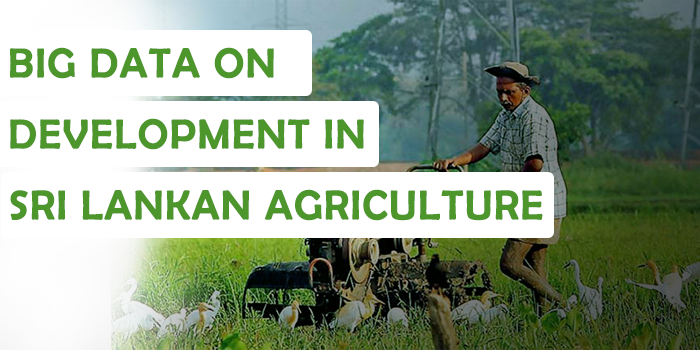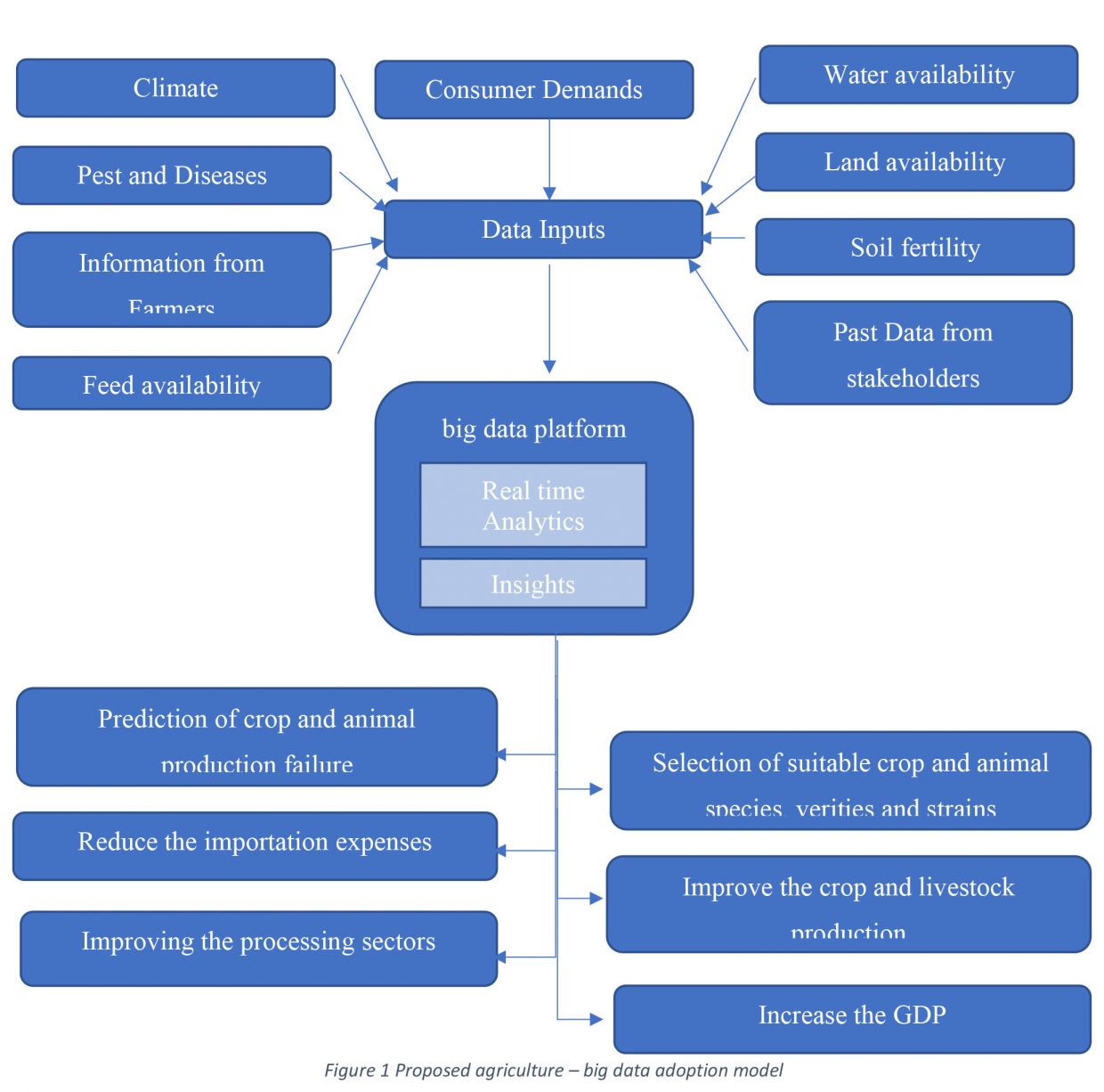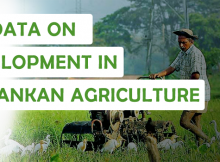BIG DATA ON DEVELOPMENT IN SRI LANKAN AGRICULTURE

Expansion of cultivation requires “transferring knowledge and details from farmers to researchers” (Pazvakavambwa & Hakutangwi, 2006). (Umali-Deininger & Schwartz, 1994) noted that: “The cornerstone of any agricultural expansion program is the transfer of agricultural knowledge to increase the productive potential of farmers.” These authors noted that the introduction of modern technologies and farm growth strategies are necessary to overcome the challenge of consumer demand and red practice. Agriculture has historically been an inherent field, with knowledge transmitted from generation to generation (Morone, 2005). Yet the problems of today, such as climate change and the loss of fertile farmland, are more nuanced and pressing. Only a cloud-based environment with the right tools and software to incorporate various data sources will revolutionize the agricultural sector to its full potential (Ghantasala, et al., 2018). Such methods would be able to aggregate data on environment, agricultural growth, weather, agricultural machinery, supply chain, diseases, fertilizer, etc. to assist farmers in decision-making. big data provides granular data for farmers on weather trends, water cycles, fertilizers and more (Ali & Kumar, 2011). It helps them make informed choices like what crops to grow, and when to harvest. The best choices eventually boost the agricultural yields. Data generation and processing grew daily and reached virtually every sector including agriculture beyond the limits of traditional techniques for data analysis. Implementing big data strategies for the agricultural sector may contribute to economic growth in terms of increased productivity and reduced impact on the environment. Agricultural items include trees, animals, and fisheries. Genetics such as variety, age, sex, and other environmental factors such as climate, soil fertility, pesticides, and attacks on diseases, etc. affect agricultural production. The data derived from above has a large quantity, scale, variety, and variability, classic big data source instances.
The Bayer Group is a life science corporation, with a worldwide scope of 150 years of experience. Healthcare and livestock primary priority, one of the most important divisions being crop science. Crop safety has also been a problem for growers, as the threat of weeds and insects. Yet if farmers are to prescribe the right herbicide and neutralize the plant, they must be willing to recognize the specific species. Bayer Digital Farming, a company within the Bayer Group, has developed an AI machine learning technology and weed detection program. Farmers send weed photographs in the software and then match the picture with a huge Bayer database (about 100,000 pictures) to classify the herb. Such technology interferes on schedule, preserves crops and yields increase (big-data-agriculture, 2020).
DTN, a Schneider Electric subsidiary, offers its customers agricultural knowledge technologies and insights into the business. DTN allows farmers and product traders to develop their market management by utilizing up-to – date weather and pricing info. Faced with the challenge of sustaining a robust data base network — ERP, accounting, GIS, agronomy, and sensing applications — to deliver real-time information to customers, the DTN ‘s current connectivity strategy has proven too expensive to support. DTN has invested in a modern data processing framework that consolidates data from a variety of sources without needing to write a ton of custom code. DTN will now integrate essential weather and agronomic data from fields to provide a simple and clear interface collection for reliable predictions. Based on those forecasts, farmers are using DTN to raise yields and lower costs. DTN has rapidly became industry standard for the sharing of ideas and has become a hub for a networked agricultural and agri-business community (big-data-agriculture, 2020).
However, agricultural stakeholders such as government , private companies, and researchers are generating, maintaining, and leveraging the overwhelming amount of data relating to agricultural production, climate and atmosphere, marketing , supply chain, etc. that need study help from big data strategies (Jones & Thornton, 2013). The big data, collected from the sources, is gathered not just for modeling probable events but also for evaluating actual examples. big data use would reduce seed damage, soil sensing and improve farmers ‘ incomes as well as decrease the excessive usage of toxic pesticides and their effects on the environment (Jones & Thornton, 2013). Nevertheless, revealing emerging patterns using big data approach requires a massive deployment of capital, equipment, and expertise, which for a single farmer is still very difficult. The implementation of small-scale farm reforms would nevertheless lead to substantial long-term outcomes (Jones & Thornton, 2013).
Using data collection and data processing from the Weather department will render micro-insurance more effective for Sri Lankan agriculture (Premaratne, 2010). “It is important to use the word details regarding structures and expertise in which things can be informative or in similar circumstances, anything can be informative about all potential situations” Buckland suggested (Hjørland, 1997). Buckland proposed to describe information as an individual – information would be treated as an item, records, text, registered knowledge, etc (Kim & Lee, 2004). Tangible systems require documents, paperwork, database management, and information development. Being an invisible object, intelligence is an information-mechanism.
Wilson (2006) discusses the contradictions of core information definitions, demonstrating that specific conceptions were developed with the aim of proposing to (McCreadie & Rice, 1999) four key interpretations of information:
- “Data as an asset / tool where data is considered a commodity to be processed, bought, etc.
- Information as data in a setting where data is readily available from an individual’s home.
- Understanding as a representation of knowledge, where information may be viewed as a guideline or a guide to knowledge in the form of written documents, e.g. posts, papers etc.
- Words are part of the process of conversation, ideas that are considered inherent of persons rather than phrases.
- Awareness is used as the process by which an informant ‘s cognitive structures are encoded and communicated to an intelligence recipient who understands, interprets and learns from the coded text.
(Gorry & Morton, 1971) explained information in the business environment and grouped it into seven of the following:
Table 1 Information type and source
Broad scope information |
Information broadly represented by it. |
| Timely information | Data obtained rapidly and in due course. |
| Current information | The digital era and its suitability for decision-making. |
| Aggregated information | Refers, for example, to the degree to which raw marketing information is given to a number of aggregations in terms of time spans and fields of obligation such as products / markets. |
| Information accuracy | The precision of the performance knowledge to meet its planned usage adequately. |
| Personal information sources, which involves direct contact with other individuals | Face to face conversations, video calls, seminars, etc. |
| Impersonal information sources |
Documents published in general, such as technical papers and business analysis studies. |
Source: (Sarmini & Maheswaran, 2018)
Information sources like DCS, DEA, and DOA will be used mainly to gather data. DCS performs all the censuses and surveys throughout the state. Increasing the networking network in the world enables more powerful ways of data processing (Pal, et al., 2018). Using portable devices such as tablet computers, personal remote assistants and GPS systems can significantly boost data collection accuracy. Electronic data transmissions that utilize the Internet would often improve the performance and timeliness of computing operations (Wilcox, et al., 2013).
The sum of agricultural knowledge matches the technical limits of modern data processing techniques. Then modern technology such as big data analytics need to be applied in agriculture to maximize production. “big data” has been used for data sets that are so large that conventional database management systems cannot accommodate them (Pauleen & Wang, 2017). Big data is a dataset that stretches beyond the scope of evaluating conventional computational tools and storing data for data acquisition, recovery, processing, and dissemination (Khalfi, et al., 2017). Therefore, big data sets can be evaluated using algorithms from big data. To evaluate new values from the obtained results, different systems, analytical techniques, and resources are required to examine big data. The number, variety, and rpm of the three big data are (Sarmini & Maheswaran, 2018). The quantity of data describes the scale of the results. Speed implies the rate at which data is generated, and diversity depends on the different types of data (Sarmini & Maheswaran, 2018).
Big data is then rescued, processed, and stored. In the case of agriculture, it is important for farmers and others to get useful information to help decision-makers (Bar-Yam, 2016). From the farmer / stakeholder’s point of view, big data analytics’ relevance depends on its ability to generate details of knowledge and value.

Source: (Sarmini & Maheswaran, 2018)
Typically, historical, and present accessible knowledge such as historical temperature data, water supply (past documents), etc., as shown in Figure 1, but cannot be used to predict results, such as selecting appropriate plants, etc.
Section 1 reveals the theoretical scientific model for recognition of big data figure 1. The system needs to be established using input parameters from past data such as weather trends, temperature variability, humidity, etc., pesticides and conditions, verbal knowledge for growers, feed supply, water and property, soil productivity, past data obtained from stakeholders and market demands. The above-mentioned inputs are critical in creating a viable platform for providing insights into the selection of suitable plants and animal forms, boosting crops and livestock production, avoiding failures in rising animals and vegetables, minimizing import expenses, boosting manufacturing sectors and eventually the GDP in the nation. By applying big data analytics, you can uncover and apply valuable hidden information to improve productivity by improved sophisticated farming methods.
Written by: Kavindya Piyasumana (Mr.)


Comments are closed.